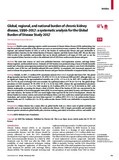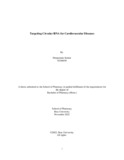Global, regional, and national burden of chronic kidney disease, 1990–2017: A systematic analysis for the Global Burden of Disease Study 2017
Citation
Bikbov, B., Purcell, C. A., Levey, A. S., Smith, M., Abdoli, A., Abebe, M., . . . Murray, C. J. L. (2020). Global, regional, and national burden of chronic kidney disease, 1990–2017: A systematic analysis for the global burden of disease study 2017. The Lancet, 395(10225), 709-733. doi:10.1016/S0140-6736(20)30045-3Abstract
Background Health system planning requires careful assessment of chronic kidney disease (CKD) epidemiology, but
data for morbidity and mortality of this disease are scarce or non-existent in many countries. We estimated the global,
regional, and national burden of CKD, as well as the burden of cardiovascular disease and gout attributable to
impaired kidney function, for the Global Burden of Diseases, Injuries, and Risk Factors Study 2017. We use the term
CKD to refer to the morbidity and mortality that can be directly attributed to all stages of CKD, and we use the
term impaired kidney function to refer to the additional risk of CKD from cardiovascular disease and gout.
Methods The main data sources we used were published literature, vital registration systems, end-stage kidney
disease registries, and household surveys. Estimates of CKD burden were produced using a Cause of Death Ensemble
model and a Bayesian meta-regression analytical tool, and included incidence, prevalence, years lived with disability,
mortality, years of life lost, and disability-adjusted life-years (DALYs). A comparative risk assessment approach was
used to estimate the proportion of cardiovascular diseases and gout burden attributable to impaired kidney function.
Findings Globally, in 2017, 1·2 million (95% uncertainty interval [UI] 1·2 to 1·3) people died from CKD. The global
all-age mortality rate from CKD increased 41·5% (95% UI 35·2 to 46·5) between 1990 and 2017, although there was
no significant change in the age-standardised mortality rate (2·8%, –1·5 to 6·3). In 2017, 697·5 million (95% UI
649·2 to 752·0) cases of all-stage CKD were recorded, for a global prevalence of 9·1% (8·5 to 9·8). The global all-age
prevalence of CKD increased 29·3% (95% UI 26·4 to 32·6) since 1990, whereas the age-standardised prevalence
remained stable (1·2%, –1·1 to 3·5). CKD resulted in 35·8 million (95% UI 33·7 to 38·0) DALYs in 2017, with
diabetic nephropathy accounting for almost a third of DALYs. Most of the burden of CKD was concentrated in the
three lowest quintiles of Socio-demographic Index (SDI). In several regions, particularly Oceania, sub-Saharan Africa,
and Latin America, the burden of CKD was much higher than expected for the level of development, whereas the
disease burden in western, eastern, and central sub-Saharan Africa, east Asia, south Asia, central and eastern Europe,
Australasia, and western Europe was lower than expected. 1·4 million (95% UI 1·2 to 1·6) cardiovascular diseaserelated deaths and 25·3 million (22·2 to 28·9) cardiovascular disease DALYs were attributable to impaired kidney
function.
Interpretation Kidney disease has a major effect on global health, both as a direct cause of global morbidity and
mortality and as an important risk factor for cardiovascular disease. CKD is largely preventable and treatable and
deserves greater attention in global health policy decision making, particularly in locations with low and middle SDI.
Description
This article was published in The Lancet [ © 2020 The Author(s). Published by Elsevier Ltd. This is an Open Access Article under the CC BY 4.0 license..] and the definite version is available at: https://doi.org/10.1016/S0140-6736(20)30045-3. The Journal's website is at: https://www.thelancet.com/journals/lancet/article/PIIS0140-6736(20)30045-3/fulltext#%20Publisher Link
https://www.thelancet.com/journals/lancet/article/PIIS0140-6736(20)30045-3/fulltext#%20Department
Brac James P. Grant School of Public HealthType
Journal ArticleCollections
Related items
Showing items related by title, author, creator and subject.
-
A new social sciences network for infectious threats
Giles-Vernick, Tamara; Kutalek, Ruth; Napier, David; Kaawa-Mafigiri, David; Dückers, Michel; Paget, John; Ahmed, Syed Masud; Cheah, Phaik Yeong; Desclaux, Alice; De Vries, Daniel; Hardon, Anita; MacGregor, Hayley; Pell, Christopher; Rashid, Sabina F; Rodyna, Roman; Schultsz, Constance; Sow, Khoudia; Wilkinson, Annie (The Lancet, 2019-05)The Ebola epidemic in the Democratic Republic of the Congo (DRC) continues to escalate, new outbreaks of Lassa fever, yellow fever, measles, and other infectious diseases erupt around the world, and antimicrobial resistance ... -
Targeting circular RNA for cardiovascular diseases
Sarkar, Deepannita (Brac University, 2022-11)Circular RNAs (CircRNAs) are ubiquitous, and covalently closed loop structures. They are single-stranded molecules without free 3′ and 5 ′ ends. CircRNAs have been rapidly gaining momentum as a potential therapy option for ... -
Gene editing for neurodegenerative diseases-A review
Sharna, Anika Islam (Brac University, 2021-10)Gene editing is quickly gaining traction as a promising treatment option for a variety of neurodegenerative diseases, including Alzheimer's disease (AD), Parkinson's disease (PD), Huntington's disease (HD), Amyotrophic ...



